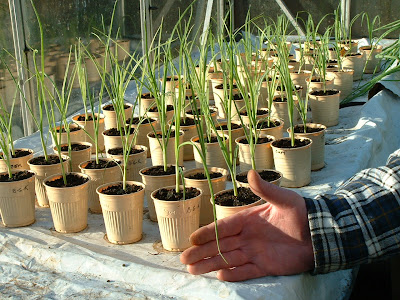
Leek seeds are best sown from the last week of January and right up until the end of February. Unlike onions which can be sown as early as December, they are best sown later in order to help prevent them from going to seed later on in the season. Using a standard seed tray filled with John Innes seed and cutting compost, sow the seeds making sure that they are well spaced - you should try and keep to about 50 seeds per seed tray. After germination - which should take about two weeks - and when the seedlings are at the crook stage, they will be ready to be potted on into individual pots. Use something small at this point such as a 9cm pot and use John Innes No 1 compost as the preferred medium.
 Allow them to continue to grow on but once they have produced their third leaf they will benefit from being potted on again into a larger pot.
Allow them to continue to grow on but once they have produced their third leaf they will benefit from being potted on again into a larger pot.Come May, your leeks will be ready to be planted outside into purpose made leek beds, but they would have needed to have been hardened off the previous two weeks.
In fact, where leeks are concerned they will still benefit from the protection of a cloche or mini poly tunnel until the beginning of June!
Your leeks will be ready for harvest from mid to late summer onwards - just make sure they get plenty of over the summer and especially during dry spells to prevent the stalks from going woody.
How to prepare a leek bed
First you will need to choose a site that has good drainage. If you do not possess such a spot then you can improve the soil structure by adding plenty of organic matter to it. In soils where even this will make little difference then you will need to consider planting your young leek plants into a mounded or raised bed.
 To get the best size out of your leeks you would dig trenches 18 inches deep - this is a job best started in late autumn or early winter when the weather is reasonably dry.
To get the best size out of your leeks you would dig trenches 18 inches deep - this is a job best started in late autumn or early winter when the weather is reasonably dry.Fork up the bottom of each trench if the base of the trench is hard, solid ground. Into each 3 square yards of trench add 70 grams of bonemeal, 85 grams of potash and 4 forkfuls of pea, bean or tomato haulms (discarded stems or seed casings). Then knocking back in the spoil, work in 1 garden barrow of well rotted farm manure.
It is essential that the greater proportion of the manure should be near the top of the bed, within approximately 4 inches if the surface to enable the leek roots to come in contact with the manure during the early stages of growth. This bed can now be left rough over the winter period.
Come March, work the top of the trench into a fine tilth and this time add 55grams of Superphosphates, 28 grams of hydrated lime or 500grams of calcified seaweed to every 3 square yards of trench.
There is no need to firm the ground unless it is very light and an advantage can be gained by covering the trenches with cloches both before and after planting. Cloches used prior to planting will warm the ground giving less of a growth check at this time.
How to blanch leeks
When growing leeks there are a number of ways that can be employed to blanch them. perhaps the most popular is this method.
The leek is planted naturally on to flat ground and allowed to grow for several weeks. When the leek is large enough a 12 inch length of 4" drainpipe is placed over the top of the plant leaving an inch or so of foliage showing over the top of it.
Never fill the pipe with compost or soil as the space is needed for the leek to grow into. For extra blanch a larger diameter pipe can be placed over the top and the inner pipe can be drawn up as the leek grows supported by moss peat at its base (moss peat is used hear as it is non-staining and easily removed by cleaning). This forms a telescopic action where the inner pipe can be continued to be lifted as required.
For related articles click onto:
Garlic - a Cure for High Blood Pressure?
Growing Giant Onions from Seed
How do you Plant Out Onion Seedlings?
How to Grow Garlic
How to Grow Garlic in Pots and Containers
How to Grow Garlic in the Garden
How to Grow Giant Cabbages
How to Grow Giant Celery from Seed
How to Grow Giant Onions
How to Grow Giant Vegetables
How to Grow Onions From Seed
How to Grow Onions from Onion Sets
How to Grow Tomatoes?
How to Make and Prepare an Onion Bed
How to Make my Recipe for English Onion Soup
How to Sow and Grow Spring Onions from Seed
Plants
Photo care of http://www.alansgarden.com/ and http://www.broadwardhall.co.uk/2010/07/harvest-time-leeks.html


















